We may not have the course you’re looking for. If you enquire or give us a call on 01344203999 and speak to our training experts, we may still be able to help with your training requirements.
Training Outcomes Within Your Budget!
We ensure quality, budget-alignment, and timely delivery by our expert instructors.
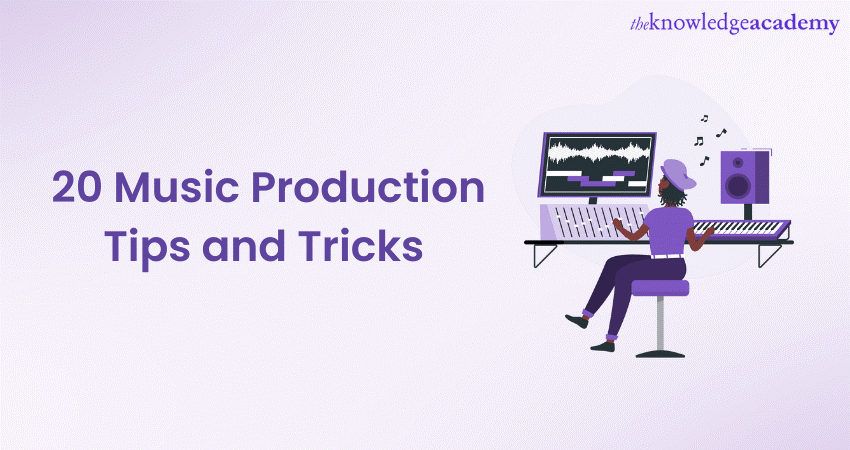
Music Production is a blend of art and science. It's the craft of transforming musical ideas into polished tracks that resonate with listeners. But without knowing some Music Production Tips and tricks, you cannot make stories come alive.
As per the IFPI Global Music Report, Europe, the world’s second-largest region for recorded music revenues, saw growth of 7.5% in 2022. This shows the importance of music in people’s lives. So, it’s time to discover essential Music Production Tips to enhance your sound; from recording to mastering, learn how to create top-notch music. Read more!
Table of Contents
1) What is Music Production?
2) 20 Music Production Tips and tricks
a) Acquire quality sound
b) Master your DAW
c) Set Up Templates
d) Embrace MIDI editing
e) Layering and stacking
f) Compression techniques
g) EQ mastery
h) Creative planning
i) Experiment with reverb
j) Automate everything
3) Conclusion
What is Music Production?
Music Production is the intricate process of creating, shaping, and arranging musical elements to compose a cohesive and compelling audio experience. It encompasses numerous artistic, technical, and creative tasks that transform musical ideas into tangible soundscapes that resonate with listeners on emotional and aesthetic levels. Basically, Music Production fuses together technical expertise with artistic vision, resulting in the birth of songs, compositions, and sonic narratives that span genres and cultures.
Unleash your musical potential with our Music Production Masterclass. Sign up today.
20 Music Production Tips and tricks
When it comes to Music Production, the pursuit of excellence is a continuous journey. Whether you're just starting out or are a seasoned producer looking to refine your skills, these 20 Music Production Tips and tricks will provide valuable knowledge and techniques to help you craft tracks that captivate and resonate with your audience. So, let’s have a detailed look at each one of them:
Acquire quality sound
One of the best Music Production Tips you will hear is setting a foundation for your sonic journey. It begins with the acquisition of high-quality sounds. The sounds you choose will shape the very essence of your compositions, determining whether they emerge as mediocre or masterful. Key factors that you need to keep in mind are:
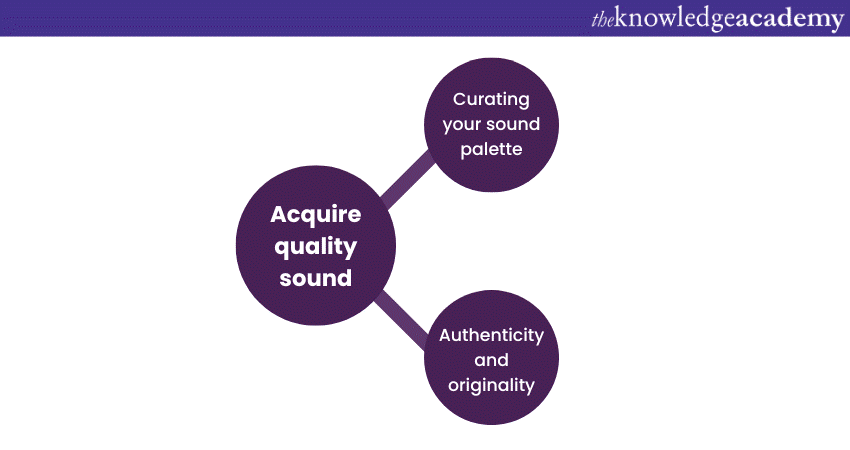
a) Curating your sound palette: Investing in premium sound libraries and sample packs can make a world of difference. These resources offer meticulously crafted sounds that have been professionally recorded and processed. From orchestral strings to electronic synths and exotic percussion, a diverse range of sounds allows you to explore a multitude of genres and styles.
b) Authenticity and originality: Starting with high-quality sounds streamlines the mixing and production process. Clean recordings and well-designed virtual instruments inherently possess a clarity that requires less effort to integrate into your mix. This means you'll spend more time sculpting your creative vision and less time fixing problematic recordings.
Master your DAW
Digital Audio Workstation (DAW) serves as the canvas upon which you paint your sonic masterpiece. Mastery of your DAW is an indispensable skill that empowers you to navigate the intricate landscape of Music Production with finesse and efficiency. Using DAW can provide you with the following benefits:
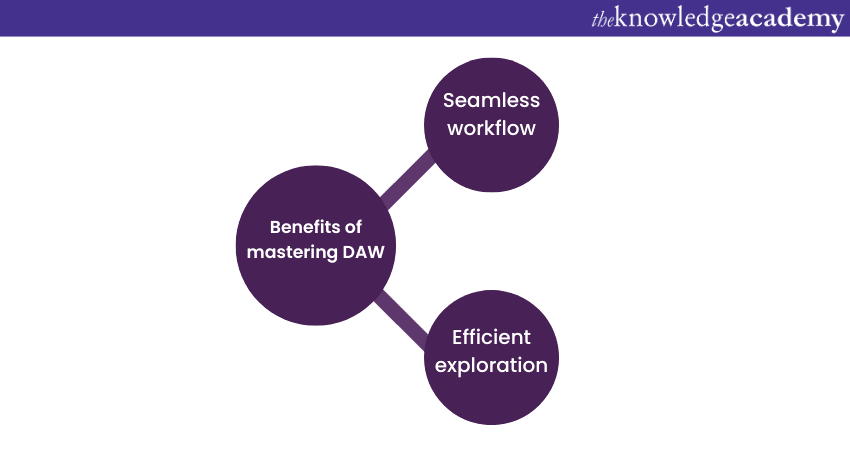
a) Seamless workflow: A deep understanding of your DAW's features and functionalities leads to a smoother workflow. Learning keyboard shortcuts, menu navigation, and customising your workspace allows you to work faster and more intuitively. As a result, you can translate your ideas into tangible results with minimal friction.
b) Efficient exploration: Mastering your DAW means you can effortlessly explore its vast range of tools and capabilities. From virtual instruments to audio effects, Musical Instrument Digital Interface (MIDI) manipulation to automation, each component becomes a tool in your creative weapon. You can experiment freely, knowing how to access and manipulate the features that shape your sound.
Set up templates
Imagine starting each new Music Production project with a setup that's tailored to your preferences, ready to accommodate your creative ideas. This is the power of setting up templates in your DAW. Here's an exploration of the benefits of creating templates and how they can significantly enhance your creative workflow:
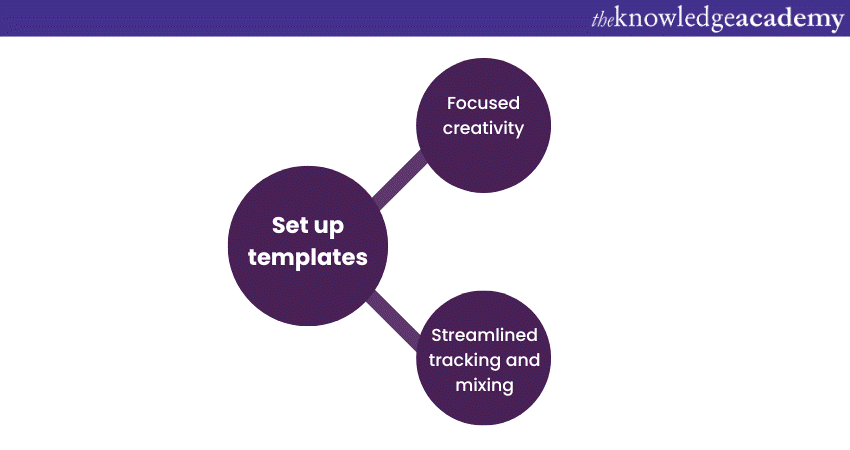
a) Focused creativity: Templates help you concentrate on the creative aspects of Music Production. With technical setup out of the way, you can immediately begin experimenting with melodies, harmonies, and arrangements. This focused creativity leads to more inspired and productive sessions.
b) Streamlined tracking and mixing: Templates can include track layouts for various instruments, saving you time when it comes to tracking and mixing. You'll have dedicated tracks for drums, bass, vocals, and more, making it easier to organise and balance your mix as you go.
Unlock the keys to musical mastery with our Piano Masterclass – play your way to excellence!
Embrace MIDI editing
MIDI Editing is a powerful tool in the realm of Music Production, allowing you to breathe life into your virtual instruments and compositions. While MIDI data represents musical notes and rhythms in a digital format, embracing it goes beyond mere technical adjustments. It enables you to infuse your productions with a human touch, precision, and creative flair that elevate your tracks to new heights. Moreover, it provides the following benefits:
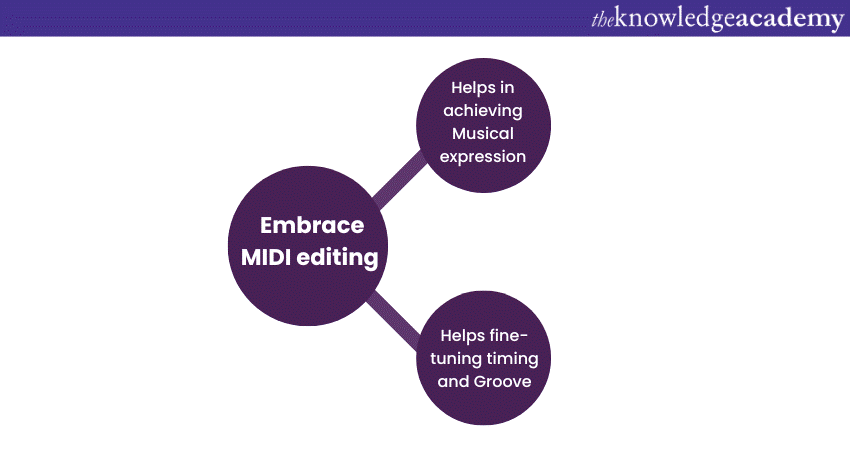
a) Helps in achieving Musical expression: MIDI Editing grants you the ability to add nuanced musical expression to your compositions. Techniques like velocity adjustments simulate the varying force of a Musician's touch on a keyboard, resulting in more dynamic and emotionally resonant performances.
b) Helps fine-tuning timing and Groove: Perfect timing is essential in Music Production, and MIDI editing lets you adjust note placements with unparalleled accuracy. From aligning notes precisely on the grid to introducing subtle timing variations for a human feel, MIDI editing ensures that your rhythm section grooves seamlessly.
Layering and stacking
Layering and stacking sounds is an artful technique that adds depth, complexity, and sonic richness to your compositions. By combining multiple instruments, samples, or textures, you can create a harmonious blend that captures the listener's attention and infuses your tracks with a unique sonic identity. It is useful for the following reasons:
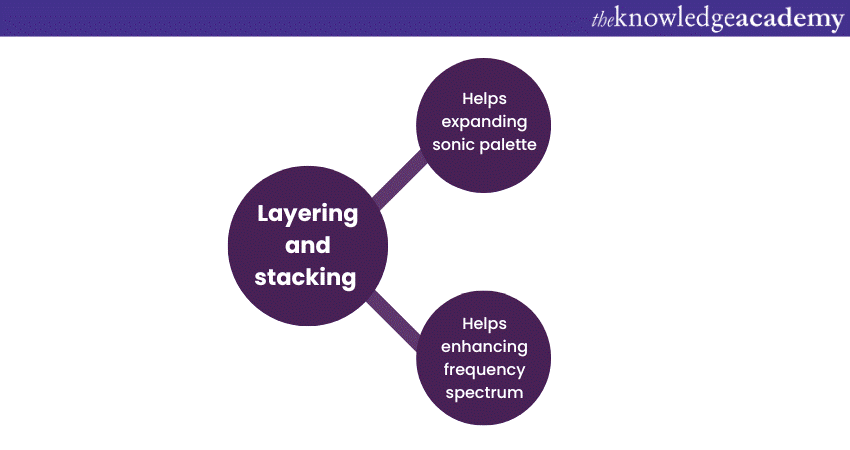
a) Helps expand sonic palette: Layering allows you to expand your sonic palette by combining diverse sounds. You can mix contrasting elements like organic instruments with electronic textures to craft a rich and dynamic musical landscape.
b) Helps enhance frequency spectrum: Each sound occupies a specific range of frequencies. Layering instruments with different frequency characteristics allows you to fill out the spectrum, avoiding clashes and ensuring a balanced mix.
Compression techniques
Compression is a vital tool that allows you to control dynamics, balance elements, and shape the overall sound of your mix. After skilfully applying compression techniques, you can enhance the impact of individual tracks and the entire Production. It helps you in the following manner:
a) Dynamic control and balance: Compression helps tame dynamic peaks, ensuring that quieter parts of a track are audible while preventing louder elements from overpowering the mix. This results in a more balanced and controlled sound.
b) Parallel compression for depth: Parallel compression, also known as New York compression, involves blending a compressed signal with the original unprocessed signal. This technique can add weight and depth to instruments like drums and vocals, preserving the natural dynamics while enhancing their impact.
EQ mastery
Equalization, or EQ, is a cornerstone of Music Production that empowers you to shape the tonal balance and clarity of your tracks. Skilfully applying EQ techniques, you can carve out space for each element, highlight important frequencies, and create a harmonious sonic. It provides the following benefits:
a) Sculpting frequency spectrum: EQ allows you to sculpt the frequency spectrum by boosting or attenuating specific frequency ranges. By removing unwanted frequencies and enhancing the strengths of each element, you create a balanced and clean mix.
b) Frequency masking avoidance: Frequency masking occurs when multiple elements compete for the same frequency range, leading to a muddy mix. EQ mastery helps you identify and address frequency clashes, ensuring each instrument has its space.
Creative planning
Creative planning serves as the blueprint that guides your journey from a musical idea to a fully realised track. Beyond the technical aspects, creative planning involves envisioning the emotional arc of your composition and structuring it to evoke specific feelings and impact. As a result, it provides the following benefits:
a) Helps in mapping emotional progression: Creative planning allows you to map out the emotional journey of your track. Consider how you want your listeners to feel as they traverse through different sections and moments and design your arrangement accordingly.
b) Dynamic contrast and buildup: Through creative planning, you can strategically incorporate moments of tension and release. Build anticipation through gradual layering and arrangement, leading to climactic peaks that maximise emotional impact.
Master the art of mixing with our expert-led Art Of Mixing Masterclass – take your music to the next level!
Experiment with reverb
Reverb is a versatile tool in Music Production that transforms soundscapes, adding depth, dimension, and atmosphere to your tracks. Experimenting with reverb, you can create sonic spaces that envelop your audience, enhancing the emotional impact of your music. You can leverage the many benefits of reverbing as it helps in:
a) Creating depth and distance: Reverb simulates the natural acoustic environment, adding depth by placing sounds in virtual spaces. By adjusting the reverb settings, you can create the illusion of distance, making instruments sound closer or farther away.
b) Ambience and atmosphere: Experimenting with reverb parameters allows you to craft different ambient environments. From intimate rooms to vast halls, each type of reverb adds a distinct character to your tracks.
Automate everything
Automation is a transformative technique in Music Production that adds dynamic movement and evolution to your tracks. By automating parameters like volume, panning, effects, and more, you can introduce intricate changes that keep listeners engaged and captivated. It provides the following benefits:
a) Dynamic shape and expressiveness: Automation allows you to shape the dynamics of individual tracks or the entire mix. You can emphasise certain phrases, create buildups, and craft impactful drops by adjusting volume levels over time.
b) Panning and spatial movement: Automated panning can move sounds across the stereo field, immersing the listener in a three-dimensional sonic landscape. Use panning automation to enhance the sense of space and separation among elements.
Vocal processing
Vocals are often the emotional heart of a song, and skilled vocal processing can transform a raw recording into a captivating performance that resonates with listeners. From enhancing clarity and emotion to fitting vocals seamlessly into the mix, effective vocal processing is a crucial skill in Music Production.
Sidechain compression
Sidechain compression is a production technique that creates rhythmic space and groove within a mix. Allowing one sound to control the compression of another, sidechain compression can be used to enhance clarity, rhythm, and dynamics.
Reference tracks
Reference tracks are a vital tool in Music Production that helps guide your sonic vision and maintain a competitive edge in the continuously evolving Musical world. After analysing and drawing inspiration from professional tracks, you can enhance your mix quality, arrangement choices, and overall production skills.
Limiting and mastering
Limiting and mastering are the final stages in the Music Production process that ensure your track achieves its full sonic potential and competes with professional releases. Limiting controls the dynamic range of your mix, while mastering ensures sonic consistency across tracks and prepares your music for distribution.
Sampling and chopping
Sampling and chopping are creative techniques that involve manipulating audio samples to create new musical elements. These techniques play a significant role in various genres, from hip-hop to electronic music, allowing producers to craft unique sonic identities.
Creative effects
Creative effects are a palette of tools that allow you to shape and manipulate sound in unconventional ways, pushing the boundaries of sonic exploration. From experimental sound design to adding unique character to your tracks, creative effects play a vital role in creating Music that stands out.
Collaboration and feedback
Collaboration and seeking feedback are essential components of the Music Production journey. By working with other creatives and inviting constructive input, you can elevate your tracks, refine your skills, and build a supportive network.
Arrange for impact
The arrangement of your music plays a critical role in capturing listeners' attention, guiding their emotional journey, and delivering a memorable experience. Crafting dynamic arrangements involves structuring your tracks to maximise impact, engagement, and narrative coherence.
Learn Music theory
Music theory provides a foundational framework that empowers you to communicate, compose, and produce with greater depth and precision. Understanding the principles of harmony, melody, rhythm, and structure enhances your creative process and opens up a world of Musical possibilities.
Trust your ears
One of the most crucial Music Production Tips is to trust your ears. It is a foundational principle in Music Production that transcends technical knowledge and equipment. Your ears are your most valuable tools for making critical decisions about your mix, arrangement, and sonic quality.
Conclusion
Masterful Music Production is a blend of technical know-how, artistic exploration, and a commitment to continuous improvement. We hope that the Music Production Tips and tricks provided in the blog helped you navigate the intricate ecosystem of Music Production, guiding you toward creating tracks that resonate deeply with your audience and stand as a testament to your creative prowess.
Elevate your hobbies and interests with our Hobbies & Interests Training – embark on a journey of lifelong learning today!
Frequently Asked Questions
Upcoming Business Skills Resources Batches & Dates
Date
 Music Production Course
Music Production Course
Fri 19th Jul 2024
Fri 6th Dec 2024







 Top Rated Course
Top Rated Course



 If you wish to make any changes to your course, please
If you wish to make any changes to your course, please


